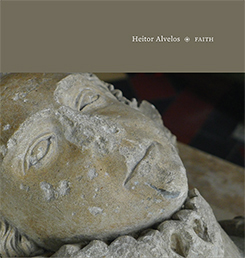Heitor Alvelos, "Faith"
 Heitor Alvelos is no stranger to the Touch label, having collaborated as a visual artist with the big names of the label such as Fennesz, BJ Nilsen, and Philip Jeck, as well as issuing sound work under a variety of pseudonyms on the associated labels. Faith is a collection of processed sound recordings and "audio irregularities", and due to their more personal and autobiographical source, it is the first record released under his own name. Essentially a single composition split into 12 segments, it is a sparse and murky record, steeped heavily in an analog sound.
Heitor Alvelos is no stranger to the Touch label, having collaborated as a visual artist with the big names of the label such as Fennesz, BJ Nilsen, and Philip Jeck, as well as issuing sound work under a variety of pseudonyms on the associated labels. Faith is a collection of processed sound recordings and "audio irregularities", and due to their more personal and autobiographical source, it is the first record released under his own name. Essentially a single composition split into 12 segments, it is a sparse and murky record, steeped heavily in an analog sound.
Culled from a variety of unspecified recordings collected by the artist since 1972, most of Faith has Alvelos sticking to an open mix, working in bass heavy sounds at often very low volumes, conjuring a sense of space and ambiguity that often becomes unsettling."Exodus" and "Edict" both have a ghostly rumble to them, distant and unspecific but always there.During the latter he begins to increase the volume and simultaneously the intensity.
On "Allvion" into "Pseudoself" the sound becomes deeper:a wavering expanse of noise that evolves into something with significant depth and variety, but never stops being discomforting.The latter especially sees Alvelos working with monotone electronics and a heavy low-frequency passage that slowly evolves and changes to become all encompassing, climaxing and leading into the silent passage of "Vicarious Solace".
He builds the minimalist, rumbling hum back up on the lengthy "The Way of Malamat." Superficially, the droning bass may seem static, but perceptible variations become prominent, at times looping into an almost rhythmic passage that again reaches a heavier, denser saturation point but never too oppressive.This continues through "Peirasmos" and "The Other," the latter resembling the muffled vibration of machinery.
In its concluding minutes, "The Hopeful Night" has him stripping the piece back to its barest essentials, largely consisting of a low volume buzz that would not be out of place on Bernhard Günter's work, albeit his sound being more digital than the analog warmth that is more prominent on Alvelos' work.The single piece that is Faith never becomes overly boisterous or forceful, but its concluding passages are especially understated.
The intentionally ambiguous source of the recordings Heitor Alvelos used to construct Faith does add an extra layer of interest to the album.Rarely does anything ever resemble what we usually consider to be a field recording, so either his processing or his selection of unconventional sources are what makes this album, probably a connection of both.It is sparse and minimalist, but done with an exceptional sense of grace and poise.
samples:
 



